
PUMPA - SMART LEARNING
எங்கள் ஆசிரியர்களுடன் 1-ஆன்-1 ஆலோசனை நேரத்தைப் பெறுங்கள். டாப்பர் ஆவதற்கு நாங்கள் பயிற்சி அளிப்போம்
Book Free DemoNaya is an old-fashioned village situated in the Midnapore district in West Bengal. The village is unique because it is the home of around 250 patuas or chitrakaars or artists. These artists have many talents in them - painting, writing songs, singing and performing songs. They are involved in a traditional folk art form called patachitra. Patachitra is the art form of storytelling through painted pictures. The pictures are painted on scrolls. A scroll is a thick sheet of paper made from plant or animal skin, used in the olden days.

A scroll.
The Chitrakaars (painters) paint stories on such scrolls and the performing artists sing the story as they keep unrolling the scroll to reveal the pictures. This art has been practised since the 13th century.
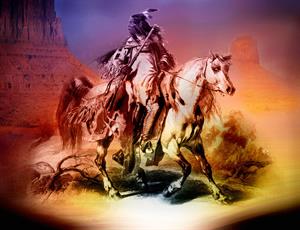
An example of the patachitra!
The storytellers carried their painted scrolls wherever they went. They go from village to village, performing the tribal folk or mythological stories. In every village, they had to unroll the scrolls one frame at a time. As they unrolled the painted scenes on the scrolls, they sang "pater gaan" or the story song. As a token of appreciation for their performance, the villagers gave them money, rice and vegetables. From mythological stories, they have now started performing stories with social messages and current events.
As days passed, people started losing interest in this art. Since there were not many viewers, the number of artists also started deteriorating. So they decided to modernize the art form. The artists adopted new themes and applied skills according to the changing times. The first step they took to achieve their goal was to establish a village called "Naya".
Pata (or pictures) were painted on a canvas made of jute fibre material. Thick sheets of poster paper (used for commercial purposes) are stitched together to make rolls. They use natural colours taken from plants such as marigold, indigo, teak leaves, saffron and turmeric. Interestingly, they also use the black flaky substance that arises from fire smoke, called lampblack. The colours are mixed in coconut shells with the gum, called sap - obtained from the bel or wood apple tree.
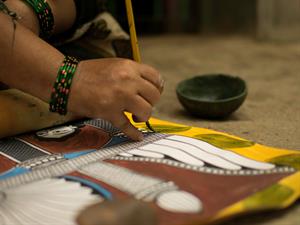
*A patua displaying the colours mixed in coconut shell!
The fluid acts as the glue in the process. Finally, a cotton cloth is stuck behind the painting so that the images holds well for a long time. The completed scroll paintings are dried in the sun and then rolled up into bundles and stored for future use.

Pictorial presentation of the art process!
Patuas are the artists who belong to the folklore of West Bengal. Now they make paintings of different shapes (square/rectangle) and sizes. Their images carry strong messages to the society:
- Conservation of trees - the importance of growing trees and how we should preserve our existing forests
- Intentional killing of female babies
- Illegal trading of children
- AIDS awareness
- Ancient topics are also covered - cat eating a lobster/fish, tigers, rows of cows/white owls
The scrolls are not too long like the ancient times. They make short ones to suit the changing times of today. However, some of them do sing their own compositions if the audience request for the same.
The patachitra art form was passed on traditionally within families, that is, from father to son. But now, many patua women have also started taking up this art. Women have been leading the "Art for Livelihood" scheme in the local area development.
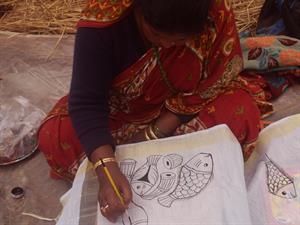
**Women took the lead in patachitra art, recently!
From the year \(2010\), every year in November, a three-day festival called Pot Maya is celebrated to mark the victory of the local artists. During the festival, they exhibit paintings of art and traditional, hundred-year-old scrolls. They paint the mud houses with colourful patachitra decorative images and hang their traditional scrolls on ropes in front of their homes. They also clean up their area and decorate with flowers to welcome the visitors to the festival. Interestingly, there are no hotels in this village to accommodate the visitors. The patuas allow the visitors as guests in their own homes and tents.
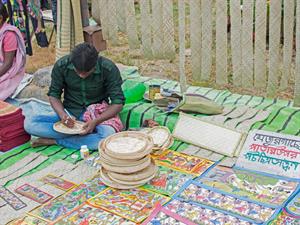
Various patachitra artworks on sale during the festival!
The usually calm village becomes a lively, high-spirited cultural centre where the guests learn about the patachitra art. There are many workshops, story-telling, and varied types of pata art are put up for sale. Also, famous artists perform musical and dance shows in the evening, which goes on until late. The artists present shows on how colours are extracted from natural sources.
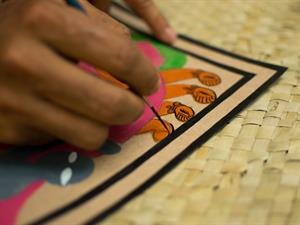
The delicate imagery of the paintings is magical!
It is a memorable experience to watch a patua artist sing softly as he reveals the scroll. It is enchanting to see the lights and shadow, produced from the oil lamps on the natural colours of the delicate pictures. One can visit this impressive village if interested in this ancient art form; it will be a captivating experience in a beautiful village setup.
Reference:
*Image courtesy: Rudra Narayan Mitra / Shutterstock.com
**Image courtesy: dkroy / Shutterstock.com